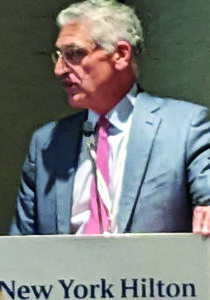
One of the earliest multispecialty public gatherings of the vascular community following the release of the first results from the BEST-CLI randomized controlled trial (RCT) raised some of the early fault lines developing between different interpretations of the study’s key data.
The co-principal investigators (PIs)—Alik Farber, MD, Matthew Menard, MD, and Kenneth Rosenfield, MD—have hailed the study as the largest RCT comparing revascularization treatment strategies in patients with chronic limb-threatening ischemia (CLTI), and have outlined how it will provide important information regarding their management.
The trio stand at the vanguard of a study that set out to be a multidisciplinary endeavor. Yet, early disagreements exist even among the PIs themselves, a facet touched on before a packed standalone BEST-CLI session at the 2022 VEITHsymposium in New York City (Nov. 15–19) by Rosenfield himself. Results from BEST-CLI showed that surgical bypass with adequate single-segment great saphenous vein (GSV) is a more effective revascularization strategy for patients with CLTI who are deemed to be suitable for either an open or endovascular approach, the investigators reported. In patients without a suitable single-segment saphenous vein, both surgical and endovascular strategies were found to be effective in treating patients with CLTI, leading the investigators to conclude that there is “a complementary role for both revascularization strategies in these patients.”
The session saw commentary being led by both Eric Secemsky, MD, representing a perspective from the endovascular community, and Michael Conte, MD, providing a view from the vascular surgery sphere.
Secemsky, section head of interventional cardiology at Beth Israel Deaconess Medical Center in Boston, said BEST-CLI provided robust critical evidence but bore limitations in terms of the inclusion of major reintervention in the primary endpoint, the representativeness of non-surgical specialties in the trial, as well as the “generalizability” of the patients enrolled. “Patient preference, surgical candidacy, prognosis, suitable anatomy, technical proficiency, costs and timely access to care remain important considerations when deciding whether to pursue a surgical versus endovascular strategy, “ he pointed out.
Conte, chief of vascular and endovascular surgery at the University of California, San Francisco, said the trial showed that open surgery and endovascular intervention “are both safe and have complementary roles in the treatment of CLTI patients.” He said that open bypass with GSV provides more effective revascularization in suitable candidates, and “is likely under-utilized in current practice,” adding that “an endo-first or endo-only approach to all patients with CLTI is not evidence-based care.” Centers carrying out less than 20% bypass in CLTI “should probably take stock.”
During the session, Farber, for his part, delved into potential trial weaknesses. “The study is not perfect; it had many limitations,” he said. “I think we need to be honest about it and lay those out.” It was a pragmatically designed trial, with the possibility for selection and operator bias in enrollment and intervention, he noted. “And equipoise and eligibility: Although everybody understands it exists, they were different across sites. There was also procedural heterogeneity.”
Farber acknowledged the trial’s cohort 2 was likely underpowered. “The anatomical complexity is yet to be evaluated,” he added. “The percentage of female patients was lower than targeted. There is no question that the Katsanos meta-analysis and its effects probably has an effect on the use of drug-coated technologies in the trial.”
Rosenfield noted the “controversy” the trial will generate: “[Amongst the BEST-CLI investigators] we have differences in the way we think it should be interpreted. My perspective is a little bit more muted than sort of the ‘Okay, this just tells the whole story about how you have to treat CLTI patients.’” His “top line,” he said, is that bypass fundamentally bears an important role in the treatment of CLTI, underscoring how the trial also showed that both procedures are safe. The lesser-discussed cohort 2, Rosenfield said, gets to one of his points of focus—that the study “raises a lot of questions that still need to be answered.”
The trial answers questions “about those patients who were randomized in the trial,” he said, continuing, “We need to unpack better what were the characteristics of those patients who were entered into the trial.” That will help specialists determine the degree to which “we can generalize the findings: to which patients does this apply?”












